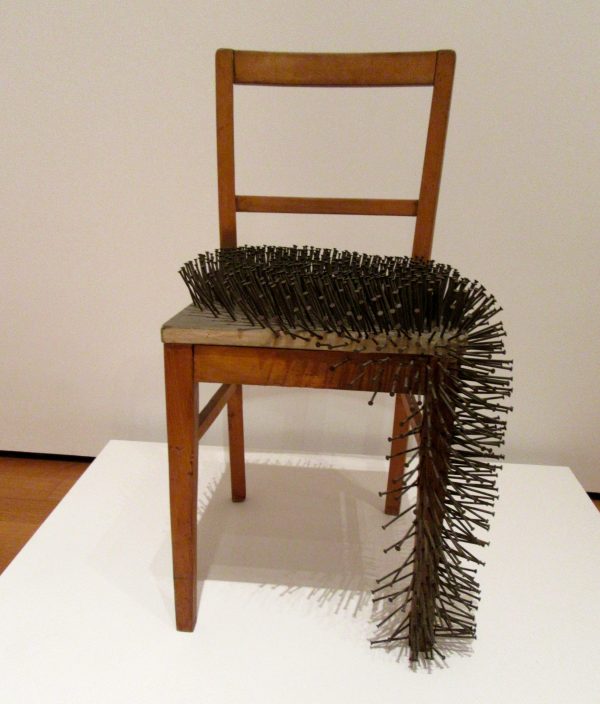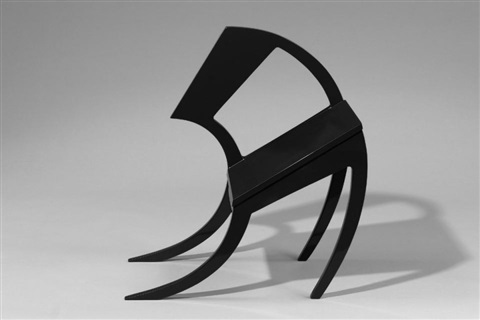NeoDada
Recall the Dada art movement after the first world war, It employed whimsical senseless art as a reaction to a senseless war. Much later, a Dada inspired group, called Fluxus, arose in the 1960s. It cultivated conceptual visual art and music.
One of its founders, George Maciunas, was asked to design a no smoking poster to be used at their meetings. The group opposed smoking even though smoking in the 1960s was popular and widespread.
The No Smoking poster, shown here in four color combinations, is noteworthy for cleverly playing back and forth with what is foreground and background.
Consider the black and white version. Here are some observations. The letters N, M, K, and G are composed of white areas, some of which you have to use your imagination to fill in or to limit. The diagonal stripe of the letter N continues into the letter M. The two Os, the S, and the G are all circular in form.
Taking a quick look at the whole, it doesn’t immediately look like writing. It might be an artful test for drunk drivers to read. I can picture them perplexed and struggling.
Conceptual Art of Objects
An opportunity for conceptual art arises from contemplating alterations that can be made to an object whose shape and characteristics are closely tied to its function. A chair is such an object.
Now, suppose the function of the chair is denied so that you can’t sit on it? Is it still a chair? To get in the mood consider the semantic question: Is a counterfeit nickel a nickel?
Please see the 2006 artwork, called Abject, made by the Spanish artist Jaime Pitarch. Notice that wood from the legs has been shaved off and is now on the seat, so all the material is still there.

Pitarch made the chair unusable by subtracting material. Use of the chair implies its destruction by collapse because of the spindly legs.
In contrast, please look at another chair that has been made unusable by addition. It is called Chair iii from 1963 by the German sculptor Gunther Uecker. The chair could bear weight but the seat is obstructed by nails. Zoomorphic interpretations are hard to resist such as an insect swarm marching up the leg or some quilled animal climbing onto the chair.
Uecker specializes in art made with nails. One popular category of his being a field of nails leaning in different directions within a rectangular planar form that hangs on a wall, much like a painting. In fact sometimes there is a painting on the board that the nails are set into. Some of these nail constructions have a fluid look, like a weather map and others have random swishy parts like cowlicks in unruly hair or grass matted down here and there in a lawn. You should see more by Google image search with Uecker’s name.

It is worth noting that art with nails has a history. Africans have for hundreds of years been making wooden power figure statues named Minkisi. The figure in human or animal form is thought to be the home of a spirit. Nails are driven into the figure to invoke the spirit in order to bind an agreement, make a vow, or seek justice or retribution. Most of those African figures have many nails and blades driven in from different directions giving an exotic and sometimes humorous effect.
Other conceptual use of chairs was done by the German sculptor Stefan Wewerka. He uses fractions of chairs in various ways, sometimes placed against a wall so that the chair appears to continue into the wall.
His most dramatic example is set up at an outer corner where two walls of a room and a hall come together. The observer sees two rear legs and the back of a chair and part of the seat cut out in a 90 degree V shape so as to touch the two walls at the corner.
Wewerka also made a deformed chair that can’t be sat on. Please see in our photo how the chair is gracefully curved, seems animated, and looks shy or curtseying.

So, why did these artists use chairs? Besides clothing, the chair comes closest to and follows the shape of our body and we do spend time in chairs ‒ kind of our best friend in furniture ‒ excluding our bed.
In summary then conceptual artists have taken a common object ‒ a chair ‒ and changed it by subtraction (Pitarch), addition (Uecker), or showing only a fraction of it or by deforming it (Wewerka).
We know the concept but what about the feelings? For that, consider a much earlier related work from 1936. It is a well known Surrealist work by Meret Oppenheim which falls into the conceptual addition category. It consists of a cup, saucer, and spoon ‒ all covered in fur. Am I right in feeling that the additions ‒ Uecker, nails and Oppenheim, fur ‒ have an unsettling sinister character? Even the Pitarch chair is disturbing due to its mutilated legs, invoking fear of harm to legs and invokes sympathy for the maimed.
Human Body Parts
Continuing with the maimed or amputated, please look at the next work, by Robert Gober. What are we to think? It seems related to Surrealism and to the absurdity of the Dada movement. In Surrealism there is typically the addition of something incongruous, but here the incongruity is by subtraction ‒ the absence of the rest of the body.
Since the wall cuts off the leg it creates the illusion that the leg continues on the other side of the wall. Of course, all of that is unsaid, thus enhancing the conceptual appeal. Would it have the same impact if the leg were out in the room away from the wall? What if more of the leg were showing or the pants were longer? And where is the other leg?

Gober actually made a similar work showing a longer leg with a candle on it. He made another work showing a pants-wearing face-down male half body from the waist down with three candles on the legs.
I find those works interesting but they have less impact than the simplest one we have on display. But the candles on the legs do add another dimension. They make the work into a memorial or a religious shrine, or a ridiculous joke.
Conceptual Art of Objects
An opportunity for conceptual art arises from contemplating alterations that can be made to an object whose shape and characteristics are closely tied to its function. A chair is such an object.
Now, suppose the function of the chair is denied so that you can’t sit on it? Is it still a chair? To get in the mood consider the semantic question: Is a counterfeit nickel a nickel?
Please see the 2006 artwork, called Abject, made by the Spanish artist Jaime Pitarch. Notice that wood from the legs has been shaved off and is now on the seat, so all the material is still there.
Pitarch made the chair unusable by subtracting material. Use of the chair implies its destruction by collapse because of the spindly legs.
In contrast, please look at another chair that has been made unusable by addition. It is called Chair iii from 1963 by the German sculptor Gunther Uecker. The chair could bear weight but the seat is obstructed by nails. Zoomorphic interpretations are hard to resist such as an insect swarm marching up the leg or some quilled animal climbing onto the chair.
Uecker specializes in art made with nails. One popular category of his being a field of nails leaning in different directions within a rectangular planar form that hangs on a wall, much like a painting. In fact sometimes there is a painting on the board that the nails are set into. Some of these nail constructions have a fluid look, like a weather map and others have random swishy parts like cowlicks in unruly hair or grass matted down here and there in a lawn. You should see more by Google image search with Uecker’s name.
It is worth noting that art with nails has a history. Africans have for hundreds of years been making wooden power figure statues named Minkisi. The figure in human or animal form is thought to be the home of a spirit. Nails are driven into the figure to invoke the spirit in order to bind an agreement, make a vow, or seek justice or retribution. Most of those African figures have many nails and blades driven in from different directions giving an exotic and sometimes humorous effect.
Other conceptual use of chairs was done by the German sculptor Stefan Wewerka. He uses fractions of chairs in various ways, sometimes placed against a wall so that the chair appears to continue into the wall.
His most dramatic example is set up at an outer corner where two walls of a room and a hall come together. The observer sees two rear legs and the back of a chair and part of the seat cut out in a 90 degree V shape so as to touch the two walls at the corner.
Wewerka also made a deformed chair that can’t be sat on. Please see in our photo how the chair is gracefully curved, seems animated, and looks shy or curtseying.
So, why did these artists use chairs? Besides clothing, the chair comes closest to and follows the shape of our body and we do spend time in chairs ‒ kind of our best friend in furniture ‒ excluding our bed.
In summary then conceptual artists have taken a common object ‒ a chair ‒ and changed it by subtraction (Pitarch), addition (Uecker), or showing only a fraction of it or by deforming it (Wewerka).
We know the concept but what about the feelings? For that, consider a much earlier related work from 1936. It is a well known Surrealist work by Meret Oppenheim which falls into the conceptual addition category. It consists of a cup, saucer, and spoon ‒ all covered in fur. Am I right in feeling that the additions ‒ Uecker, nails and Oppenheim, fur ‒ have an unsettling sinister character? Even the Pitarch chair is disturbing due to its mutilated legs, invoking fear of harm to legs and invokes sympathy for the maimed.
Human Body Parts
Continuing with the maimed or amputated, please look at the next work, by Robert Gober. What are we to think? It seems related to Surrealism and to the absurdity of the Dada movement. In Surrealism there is typically the addition of something incongruous, but here the incongruity is by subtraction ‒ the absence of the rest of the body.
Since the wall cuts off the leg it creates the illusion that the leg continues on the other side of the wall. Of course, all of that is unsaid, thus enhancing the conceptual appeal. Would it have the same impact if the leg were out in the room away from the wall? What if more of the leg were showing or the pants were longer? And where is the other leg?
Gober actually made a similar work showing a longer leg with a candle on it. He made another work showing a pants-wearing face-down male half body from the waist down with three candles on the legs.
I find those works interesting but they have less impact than the simplest one we have on display. But the candles on the legs do add another dimension. They make the work into a memorial or a religious shrine, or a ridiculous joke.

Comments
Post a Comment
You are invited to comment if you wish.